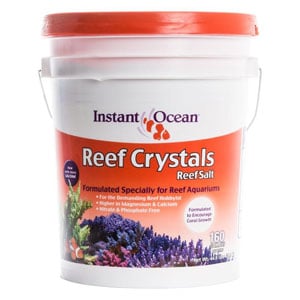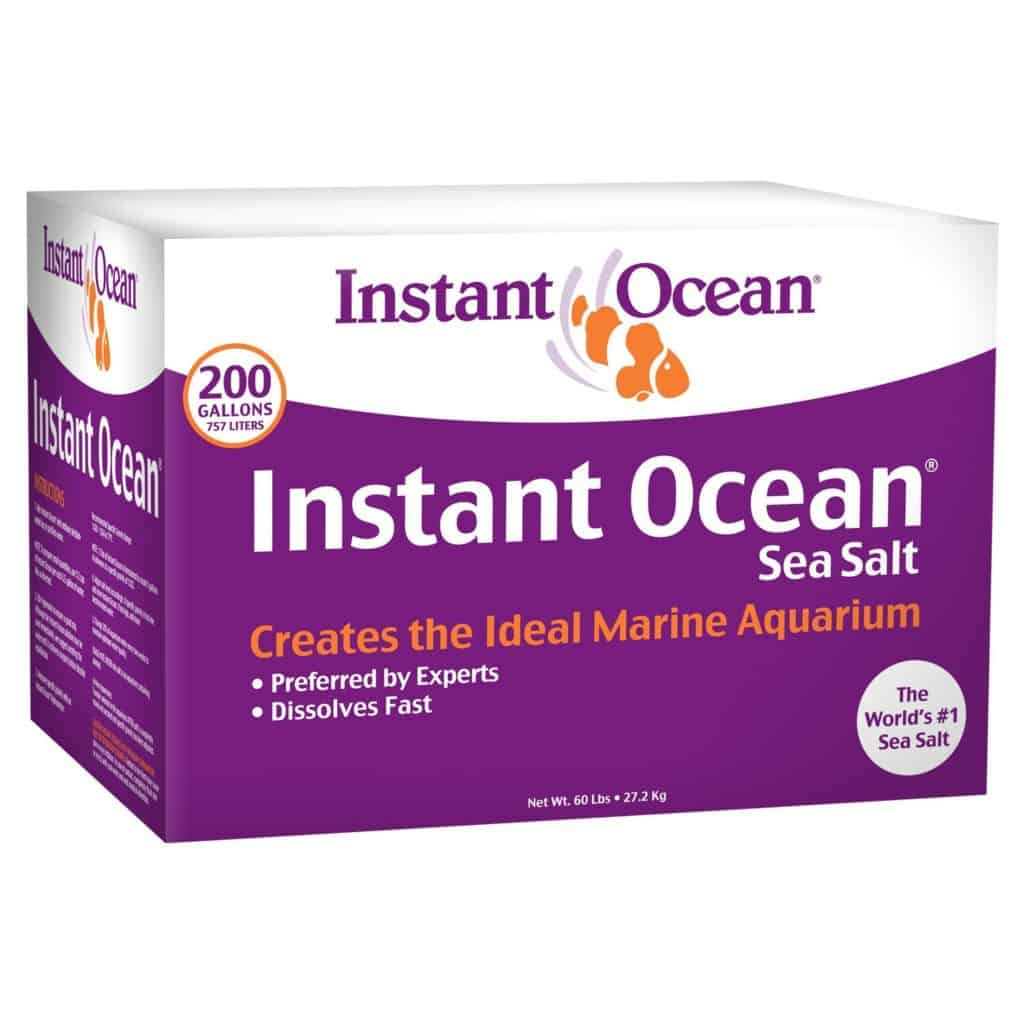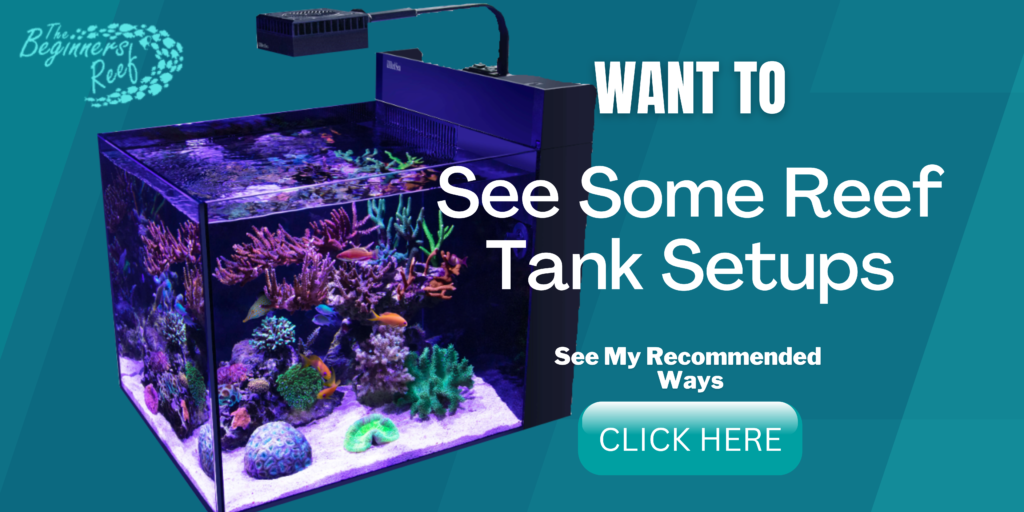For beginner aquarists to saltwater one of the most daunting tasks is correctly making the saltwater itself. The thought of getting it wrong and everything dying fills many beginners with dread, but it is actually a very straightforward process.
For a home saltwater aquarium, the salt content in the water needs to remain consistent at around 1.025 S.G. or 35ppt. Purposely engineered aquarium salt granules mix at a ratio of 1/2 cup for every US gallon or 36g per liter of fresh water. The use of a refractometer will be needed to test the ratio.
Once you have read this article you will have no fears about what you need and how to mix the salt and water to give you the perfect mix ready for addition to your new shiny aquarium. It is very straight forward and you will become a water change master in no time!
Before you begin mixing, you need to ensure you have the right kind of salt for the aquarium. Regular table salt will not do!
What Kind of Salt Mix Should You Use in an Aquarium?
Salt mixes for home aquariums are highly engineered to provide optimal water conditions for fish, coral, and invertebrates. It is not only the salinity that they provide but dozens of trace elements like Calcium, Magnesium, Carbonate, Strontium that the invertebrates use as building blocks for their skeletons.
There are many great brands that have decades of pedigree behind them so picking a salt is easy. The salt that I have personally been using for over a decade is Reef Crystals from Instant Ocean.
You can get it Here at Amazon.com
Each brand of salt can mix may be mixed to slightly different quantities so be sure to always read the manufacturer’s information when starting a new brand of salt. Some mixes are specially made for fish-only aquariums, whereas Reef Crystals is aimed at aquariums with large coral populations. No matter which salt mix you pick, they will all work, the ones with more trace elements for corals are just a little more expensive!
When selecting a salt mix stay away from freshwater aquarium salt which is used by freshwater aquarists to recreate brackish water conditions. Although these salt mixes will work to create the correct salinity they do not contain the trace elements like sodium, chloride, sulfate, and magnesium necessary for marine organisms to thrive.
How Much Salt Mix Should You Use in an Aquarium?
For a home saltwater aquarium, the salt content in the water needs to remain consistent at around 1.025 S.G. or 35ppt. Purposely engineered aquarium salt granules mix at a ratio of 1/2 cup for every US gallon or 36g per liter of fresh water. The use of a refractometer will be needed to test the ratio.
Most saltwater aquariums run at a temperature of around 78°F (25.5°C) to 80°F (26.6°C) so the salt mixes will have to be measured and tweaked to ensure 1.025sg at your selected temperature – I run my aquarium at 78°F (25.5°C).
Some brands will give you a volume to measure, whereas other brands will give you a weight to measure out. Whichever brand you pick, just follow the instructions printed on the side of the packaging. Just measure out the recommended amount of salt granules and add it to the mixing container with fresh water. A pump is then used to mix it and a heater to warm it.
This then turns your bucket of water into saltwater!
Here are some of the best salt mixes for beginners and how each manufacturer recommends they are measured to achieve a salinity of 1.025 at 25°C/77°F:
| Salt Brand | Mixing Recommendation |
|---|---|
| Instant Ocean | 1/2 Cup per 1 U.S. Gallon |
| Red Sea Salt | 136g per 1 U.S. Gallon |
| Tropic Marin Classic Salt | 1/2 Cup per 1 U.S. Gallon |
| Neomarine Salt Mix | 134g per 1 U.S. Gallon |
Below is a list of common aquarium sizes and how much salt mix they require on initial fill using the most popular beginner salt mix, Instant Ocean at 1/2 Cup per U.S. Gallon, or 36g per Liter.
| Aquarium Size | Cups Required | Kg Required |
|---|---|---|
| 15 Gal or 56 Liter | 7.5 Cups | 2.0 Kg |
| 20 Gal or 75 Liter | 10 Cups | 2.7 Kg |
| 55 Gal or 208 Liter | 22.5 Cups | 7.5 Kg |
| 75 Gal or 284 Liter | 38.5 Cups | 10.2 Kg |
| 90 Gal or 340 Liter | 45 Cups | 12.2 Kg |
| 120 Gal or 454 Liter | 60 Cups | 16.3 Kg |
| 150 Gal or 568 Liter | 75 Cups | 20.4 Kg |
| 180 Gal or 681 Liter | 90 Cups | 24.5 Kg |
| 240 Gal or 908 Liter | 120 Cups | 32.7 Kg |
| 300 Gal or 1,135 Liter | 150 Cups | 40.9 Kg |
If the aquarium contains a sump, refugium, and frag tank be sure to also account for the water volume in them too. Use this guide to get close then fine-tune the final ratio using a calibrated refractometer (See Below).
How To Correctly Mix Aquarium Salt
Mixing salt for an aquarium is best done in a food-grade bucket using a pump and heater set to 78°F/25.5°C. Make a note of how much water went into the bucket and add salt at 1/2 Cup/Gal or 36 g/liter and allow it to mix for 20-30 minutes. Test with a refractometer before adding to the aquarium.
If this is going to be the first time you have mixed saltwater for your new aquarium there is a fairly simple process that you can use, but you will need to gather the following items before you start:
(All Links to Amazon.com for Reference)
- Clean/Unused Bucket for a small aquarium. A Brute Trashcan for large aquariums
- Heater
- Thermometer – I like the digital ones for easy reading
- Small Powerhead pump for mixing
- Measuring Cups or Baking Scales
- Refractometer
- Old Towels
- RO/DI Water Filter or Decholrinating Solution for Tap Water
Before you begin be sure to place down towels. Salt granules or saltwater can stain carpets and flooring!
This is the exact method I have been using for decades and it works every time!
Step 1
If you have a brand new tank and this is going to be the initial fill you can do your mixing in the tank but do not add the live sand or live rock at this point. The freshwater will kill all living organisms and beneficial bacteria on them. They can be added later once the water is up to temperature and at the correct salinity.
Just be sure to only fill the aquarium around 2/3 full to account for displacement once the sand and rock go in. You can then mix the rest if required in a bucket and add it to the tank after.
Do not use any detergent when rinsing your new bucket/trashcan, just warm water and a cloth to wipe away manufacturing oils.
Food-grade containers are recommended because low-grade plastic can leach phosphate into the water over time.
If you wish to do your aquascape and insert the sand first, then mix your water in the trashcan/bucket.
Step 2
Fill the tank or container with water. If you can, get yourself an RO/DI water filter (See Further Reading section at the end) to help prevent water quality issues for the life of your aquarium! If not, use the Prime Decholrintor solution to treat the tap water as per its dosage instructions.
Step 3
Turn on the heater and pump to circulate and bring the water up to 78°F or 25.5°C. On a large aquarium, this could take several hours. More than one heater can be used to speed up the process.
Step 4
Once up to temperature, begin to add the salt following the manufacturer’s recommended dosage of around 1/2 cup per US gallon, or 36g per liter.
Step 5
Allow the water pump to mix the water and salt solution. Don’t worry if you see any sand-like residue or cloudy water, that is normal. Ensure all salt granules get dissolved.
Step 6
After around 30 minutes take a salinity reading. Add water if the salinity is too high, add more salt if the salinity is too low.
Step 7
Allow mixing for several hours to several days to get the salinity content dead on. Repeat Step 6 as needed.
Step 8
If you decided to add your rock and sand later, now is the time to do it. Slowly add your rock to create your aquascape, then add the sand! Adding rocks on top of sand can cause them to topple when burrowing critters get added to your tank. Rock on glass is fine, just be slow!
Step 9
Mix some more saltwater in your bucket/trashcan and add it to the aquarium to bring up the water level to the correct operating height once all the rock and sand are in. Be sure to fill enough for the sump/filters.
Step 10
Your tank will go cloudy for several days, allow the filters to run and pull out the suspended debris.
Your aquarium is now full and you can begin the fun of cycling the tank ready for it to become a full saltwater reef tank!
For lots more detailed articles on water changes and cycling your tank be sure to check out the Further Reading section at the end of this article.
How Do You Measure the Salinity of a Saltwater Mix?
Salinity can be measured in an aquarium using a Hydrometer, Refractometer, or an Electronic Sensor and Meter. The electronic meters and refractometer are the most accurate with the refractometer being the most popular amongst aquarists due to its low price, ease of use, and can be readily calibrated.
The unit of measure for salinity is known as specific gravity or sg. The ideal salinity for a home aquarium is 1.025sg or 35ppt, but the tolerable range is 1.021sg to 1.026sg depending on what livestock you have.
Pure water has a specific gravity of 1sg. If your saltwater mix measures 1.025sg, it means that it is 1.025x denser than pure water.
Here are some typical salinity ratios for various types of saltwater aquariums:
| Salinity | Fish-Only Aquariums | Mixed Reef Aquariums | SPS Aquarium |
|---|---|---|---|
| SG | 1.021sg | 1.023sg | 1.025sg |
| PPT | 28ppt | 31ppt | 35ppt |
PPT = Parts Per Thousand
My recommendation is that if you wish to only keep fish, then mix your water to 1.021sg.
If you plan on keeping invertebrates and corals then begin your aquarium at 1.025sg.
To be able to measure the amount of salt content in your water there are three options available to the aquarist:
- A Hydrometer – Cheap, but hard to read
- A Refractometer – Most Used Option
- An Electronic Salinity Meter – Highly accurate but expensive
Let’s go into a brief introduction of each of these measuring instruments:
Hydrometers
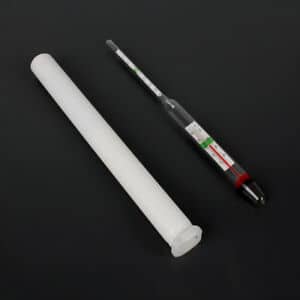
Hydrometers measure specific gravity by using the concept of buoyancy. You float the hydrometer on the surface of the water and it will give you the sg reading based on where the water level touches its measuring stem. Reading the stem can be quite difficult.
Refractometers
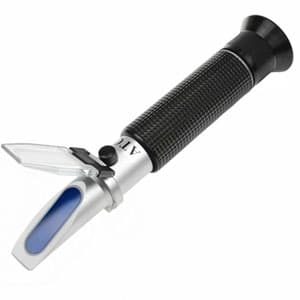
Refractometers determine salinity by measuring the light refraction caused by the salt in the water and self-correct for temperature. You place a drop of water on the prism and view the result through the eyepiece. They are fast to use and can be easily calibrated with a simple solution.
A Refractometer is what I recommend you use. For around $35 it will last you forever (mine is 15 years old and still works perfectly!) and give you highly accurate results within 30 seconds of taking it out of the box!
You can find it Here at Amazon.com
Caibration Solution Here at Amazon.com
Electronic Salinity Meters
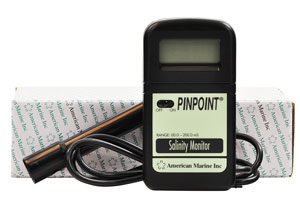
Salinity meters use a sensor to measure the salt content in the water. They are very simple to use and give an easy-to-read numerical value. They are easily calibrated using a test solution.
You can find the Pinpoint Salinity Meter Here at Amazon.com
For lots more detailed information about measuring salinity please see our article in the further reading section below.
To Finish
In order to create artificial saltwater, use as pure a water source as you can and a recognized aquarium salt mix.
Use the recommended dosage of around 1/2 cup per gallon or 36g per liter, but be sure to follow the specific instructions provided by the salt manufacturer to achieve a salinity reading of around 1.025sg/35ppt at 78°F(25.5°C) for your new aquarium. For partial water changes, salinity and temperature levels must match that of the existing tank water.
Further Reading
Before you get too far unto your aquarium journey I recommend the following articles to help you progress seamlessly:

